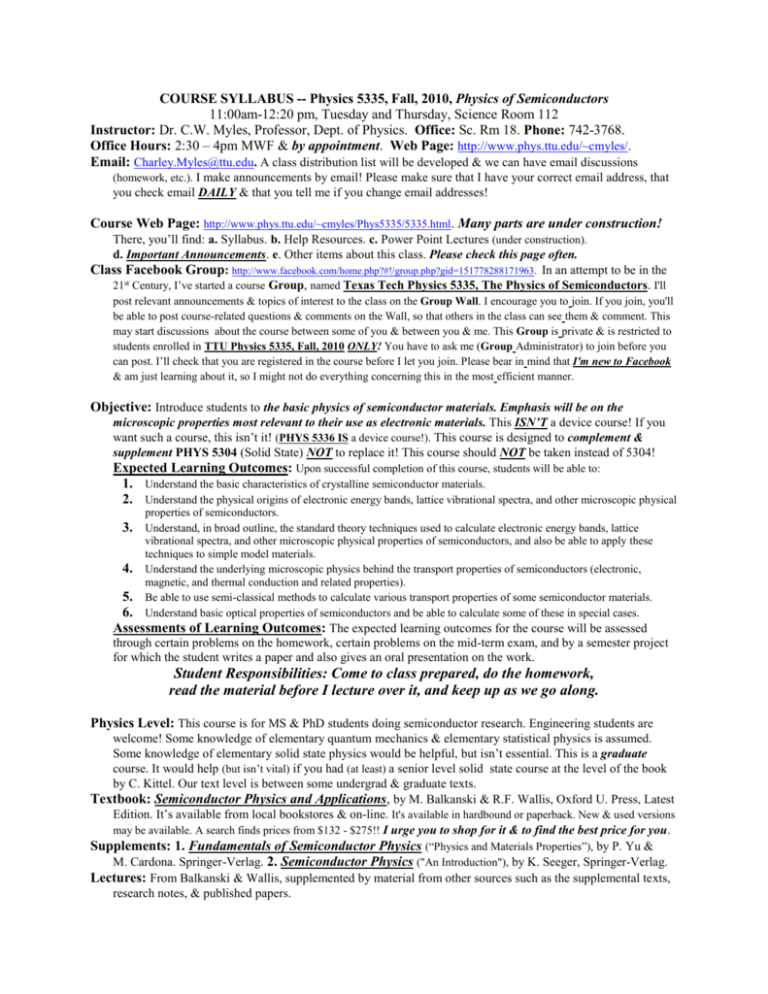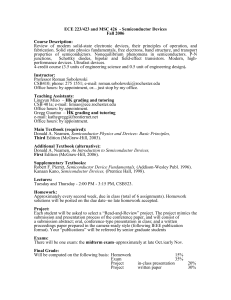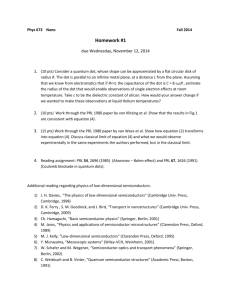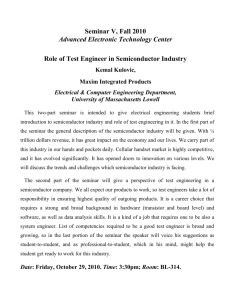COURSE SYLLABUS -- Physics 5335, Fall, 2003
advertisement

COURSE SYLLABUS -- Physics 5335, Fall, 2010, Physics of Semiconductors 11:00am-12:20 pm, Tuesday and Thursday, Science Room 112 Instructor: Dr. C.W. Myles, Professor, Dept. of Physics. Office: Sc. Rm 18. Phone: 742-3768. Office Hours: 2:30 – 4pm MWF & by appointment. Web Page: http://www.phys.ttu.edu/~cmyles/. Email: Charley.Myles@ttu.edu. A class distribution list will be developed & we can have email discussions (homework, etc.). I make announcements by email! Please make sure that I have your correct email address, that you check email DAILY & that you tell me if you change email addresses! Course Web Page: http://www.phys.ttu.edu/~cmyles/Phys5335/5335.html. Many parts are under construction! There, you’ll find: a. Syllabus. b. Help Resources. c. Power Point Lectures (under construction). d. Important Announcements. e. Other items about this class. Please check this page often. Class Facebook Group: http://www.facebook.com/home.php?#!/group.php?gid=151778288171963. In an attempt to be in the 21st Century, I’ve started a course Group, named Texas Tech Physics 5335, The Physics of Semiconductors. I'll post relevant announcements & topics of interest to the class on the Group Wall. I encourage you to join. If you join, you'll be able to post course-related questions & comments on the Wall, so that others in the class can see them & comment. This may start discussions about the course between some of you & between you & me. This Group is private & is restricted to students enrolled in TTU Physics 5335, Fall, 2010 ONLY! You have to ask me (Group Administrator) to join before you can post. I’ll check that you are registered in the course before I let you join. Please bear in mind that I'm new to Facebook & am just learning about it, so I might not do everything concerning this in the most efficient manner. Objective: Introduce students to the basic physics of semiconductor materials. Emphasis will be on the microscopic properties most relevant to their use as electronic materials. This ISN’T a device course! If you want such a course, this isn’t it! (PHYS 5336 IS a device course!). This course is designed to complement & supplement PHYS 5304 (Solid State) NOT to replace it! This course should NOT be taken instead of 5304! Expected Learning Outcomes: Upon successful completion of this course, students will be able to: 1. Understand the basic characteristics of crystalline semiconductor materials. 2. Understand the physical origins of electronic energy bands, lattice vibrational spectra, and other microscopic physical properties of semiconductors. 3. Understand, in broad outline, the standard theory techniques used to calculate electronic energy bands, lattice 4. vibrational spectra, and other microscopic physical properties of semiconductors, and also be able to apply these techniques to simple model materials. Understand the underlying microscopic physics behind the transport properties of semiconductors (electronic, magnetic, and thermal conduction and related properties). Be able to use semi-classical methods to calculate various transport properties of some semiconductor materials. Understand basic optical properties of semiconductors and be able to calculate some of these in special cases. 5. 6. Assessments of Learning Outcomes: The expected learning outcomes for the course will be assessed through certain problems on the homework, certain problems on the mid-term exam, and by a semester project for which the student writes a paper and also gives an oral presentation on the work. Student Responsibilities: Come to class prepared, do the homework, read the material before I lecture over it, and keep up as we go along. Physics Level: This course is for MS & PhD students doing semiconductor research. Engineering students are welcome! Some knowledge of elementary quantum mechanics & elementary statistical physics is assumed. Some knowledge of elementary solid state physics would be helpful, but isn’t essential. This is a graduate course. It would help (but isn’t vital) if you had (at least) a senior level solid state course at the level of the book by C. Kittel. Our text level is between some undergrad & graduate texts. Textbook: Semiconductor Physics and Applications, by M. Balkanski & R.F. Wallis, Oxford U. Press, Latest Edition. It’s available from local bookstores & on-line. It's available in hardbound or paperback. New & used versions may be available. A search finds prices from $132 - $275!! I urge you to shop for it & to find the best price for you. Supplements: 1. Fundamentals of Semiconductor Physics (“Physics and Materials Properties”), by P. Yu & M. Cardona. Springer-Verlag. 2. Semiconductor Physics ("An Introduction"), by K. Seeger, Springer-Verlag. Lectures: From Balkanski & Wallis, supplemented by material from other sources such as the supplemental texts, research notes, & published papers. Other Possible Supplements: There are many books on semiconductors & devices at various levels of depth & difficulty. In Rm. 18, I have shelves full of them! The library has many more. Mine are available to look at & check out. In a graduate course, I expect you to go to sources other than the texts to obtain different treatments of the material! I sometimes lecture from outside the text (e.g. from the literature or my own research notes). The text & the supplements have extensive bibliographies for each chapter. USE THEM! Web resources are abundant! Course Topics: Survey of basic semiconductor materials physics. As a survey, topics must be covered rapidly. A goal is to cover, as an overview, selected topics in Chs. 1-10 of text. Detailed coverage will be announced as we go. An approximate schedule of topics is on the next page. Grades: Homework = 40%, Midterm Exam = 30%, Project = Paper + Presentation = 30%. Grades are based on homework, one exam & a project with a paper and a class presentation. Homework: Will be assigned regularly. Doing it is your best means of learning physics! It is impossible to do this without working problems! Homework is due at 5pm on the due date. To keep up, do assignments as soon as material is covered. Problems are NON-TRIVIAL! If you wait to the last day, you likely will run into trouble! No late homework will be accepted. Homework may be done individually or in consultation with others. The latter is encouraged; this is how scientists work in real situations! Exam: There will be one exam near midterm. This will aimed at evaluating the students’ grasp of the physics & identification of the most relevant physical processes. Also, it will have a take home portion with problems to assess progress in using relevant mathematical tools. Semester Project: Library Research Paper + Presentation: On an advanced topic or application of semiconductor physics that we don’t have time for in class. The paper is due near the end of the semester. Oral presentations on the same subject will take place then. You should have the topic picked by mid-semester. Topics must be approved by me before you begin. The paper should be 5 to 10 typed pages & written in the style of a scientific paper, with all (several) sources properly cited. The presentation should be about 0.5 hour long. It can be (but isn’t required to be!) done in Power Point. Approximate Grade Scale: 100 > A > 88 > B >76 > C > 64 > D > 52 > F > 0 Approximate Lecture Schedule (Balkanski & Wallis = B, Yu & Cardona = Y, Seeger = S) Topic: Chapters Approx. No. of Lectures 1. Introduction & Survey: B, Ch. 1; Y, Ch 1; S, Ch 1 2 2. Electronic Energy Bands (Basics): B, Ch. 2; Y, Ch 2; S, Ch 2 2 3. Electronic Energy Bands (Semiconductors): B, Ch. 3; Y, Ch 2; S, Ch 2 3 4. Kinematics & Dynamics of Electrons & Holes: B, Ch. 4; Y, Ch. 5; S, Ch. 4 2 5. Electronic Effects of Impurities & Defects: B, Ch. 5; Y, Ch 4 3 6. Semiconductor Statistics: B, Ch. 6; S, Ch 3 2 7. Lattice Vibrations; Phonons: B, Ch. 7; Y, Ch 3 3 8. Charge Carrier Scattering/Transport (selected): B, Ch. 8; Y, Ch. 5; S, Chs. 4, 5 3 9. Diffusion (selected): S: Ch. 5 1 10. Surfaces and Interfaces: B, Ch. 9; Y, Ch. 8 (selected); S, Ch 14 2 11. Optical Properties (selected): B, Ch. 10; Y, Chs 6 & 7; S, Chs 11 & 12 3 12. “Hot” Electrons & Breakdown: Y, Ch 5; S, Chs. 6, 10 1 13. Quantum Confinement: B, Ch. 20; Y, Ch 9; S, Chs 9 & 14 1 _____ TOTAL 28 This is not meant to be rigid, but to give us an idea where we are going. Some topics in some chapters may be omitted; some topics from outside sources will be included. IMPORTANT DATES Tues., Aug. 31: Last day to add a course. Mon., Sept. 13: Last drop date with refund. Mon., Oct. 11-Tues, Oct. 12: “Fall Break”, NO CLASS! Mon., Sept. 6: Labor Day, NO CLASS! Thurs., Sept. 23: Last withdraw date with refund. Thurs., Oct. 21-Sat., Oct. 23: I’ll be out of town! Mon., Nov. 1: Last drop date. Wed, Nov. 24-Sun, Nov 28: Thanksgiving, NO CLASS! Wed, Dec 8: Last class. Mon, Dec. 20: Grades are due! TO BE SCHEDULED: Fri., Dec. 10-Wed., Dec. 15 (Final Exam time): Student presentations. I may be out of town a few other times. I’ll arrange a substitute for any other times I am gone. ACADEMIC INTEGRITY Academic dishonesty will not be tolerated. Students caught in this type of behavior will be punished to the fullest extent allowed by TTU. See TTU Student Handbook or Catalogue. CLASSROOM CIVILITY AND ETIQUETTE Students are expected to assist in maintaining an environment which is conducive to learning. To assure that everyone has an opportunity to gain from class time, you are expected to adhere to the following Simple Rules of Classroom Etiquette In the classroom, students are prohibited from using cell phones (either talking OR texting!), eating/drinking, making offensive remarks, reading newspapers or other unrelated material, visiting with your neighbor, sleeping or engaging in other forms of distraction. Inappropriate behavior of this kind shall result in, minimally, a request to leave class. 2. It is extremely rude, to both the instructor and to other students, to leave during a lecture or to arrive very late. Since attendance of lectures is optional, please do not come to class if you are unable to attend for the full duration or if you are not able to arrive on time! Physical illness is an obvious exception to this rule. Since class begins at 11:00am, “oversleeping” is never an excuse for lateness. If you have an expected reason to leave early, please tell the instructor at the beginning of class and sit in a convenient location for leaving without disturbing the class. 3. No laptops or any other electronic devices are allowed to be operational in class unless the need for such device for reason of a disability is documented by Access TECH. 1. DISABILITY STATEMENT Any student who, because of a disability, may require special arrangements in order to meet the course requirements should contact the instructor as soon as possible to make any necessary arrangements. Students should present appropriate verification from Student Disability Services during the instructor’s office hours. Please note instructors are not allowed to provide classroom accommodations to a student until appropriate verification from Student Disability Services has been provided. For additional information, you may contact the Student Disability Services office in 335 West Hall or 806-742-2405. General Physics resources which might give useful semiconductor links. 1. TIPTOP. (The Internet Pilot to Physics). Go to http://physicsweb.org/TIPTOP/. Click on Search for a Physics link. This leads to Physics Web, a search engine for physics. (This is based in the U.K., so it has a U.K.–European flavor). Under “Fields of Interest”, choose “Semiconductors”. This leads to 33 entries! These range from very elementary to very advanced resources, including some research journals. 2. THE AMERICAN PHYSICAL SOCIETY. Go to the http://www.aps.org/. Click on Physics Internet Resources. Follow the links to Physics by Fields, to Solid State, to Semiconductors. There are a lot of other links that can be followed, but I have not taken the time to do so. Alternatively, put in “semiconductors” in the search engine on the APS homepage. This gives 5,434 documents!! NOTE: APS is a 40,000 + member organization of professional physicists from around the world. Everyone who wants to be a professional physicist should join! If you are not a member yet, you should join. There is NO excuse for not doing this! For students, the first year's membership is free (ask the office for an application form, which must be signed by the Chairman). You get free Physics Today, APS News, discounted journals. 3. THE MATERIALS RESEARCH SOCIETY. Go to http://www.mrs.org/. Click on “Materials Connections”. Put “semiconductor” in the search engine. This gives a number of further links to pages with various types of semiconductor links & info. NOTE: MRS is also a worthwhile professional organization to join for professional materials researchers. It is multidisciplinary & has members whose education is in physics, electrical engineering, mechanical engineering, chemical engineering, chemistry, materials science, and others. 4. THE AMERICAN INSTITUTE OF PHYSICS. Go to http://www.aip.org/. Click on “Search”. Put “semiconductors” in the search engine. This gives 14,204 documents! 5. COMPERCIAL SEARCH ENGINES. GOOGLE: http://www.google.com/. Type “Semiconductor Physics” into this and you will get millions of web pages! Other commercial search engines are obviously also possible. Amusing Semiconductor Physics Site! “Britney Spears' guide to Semiconductor Physics”: http://britneyspears.ac/lasers.htm B. Web pages with interactive Java Applets in semiconductor / or solid state physics. Below, I list a few web pages I have found which have Java Applets or “Physlets” which have interactive exercises which might be useful in learning some basic semiconductor and / or basic solid state physics concepts. These are only the ones which I found after searching the web for about an hour. There certainly may be others. I urge you to try some of these out and to try to find others. If you find some which are particularly interesting and useful, please share them with me and the class! Thanks. These Applets can be fun and entertaining, as well as educational. 1. A Guide to Semiconductors: http://www.techlearner.com/Semiconductors.htm 2. The Semiconductor Physics Applet Service: http://jas.eng.buffalo.edu/ 3. Automated Internet Measurement Laboratory; Semiconductor Device Measurements Using the Internet: http://nina.ecse.rpi.edu/shur/Remote/ 4. Purdue University’s ECE 557 Home Page: http://shay.ecn.purdue.edu/~ee557/oldIndex.html 5. Martindale’s Calculators: http://www.martindalecenter.com/Calculators4A_1_Semi.html


